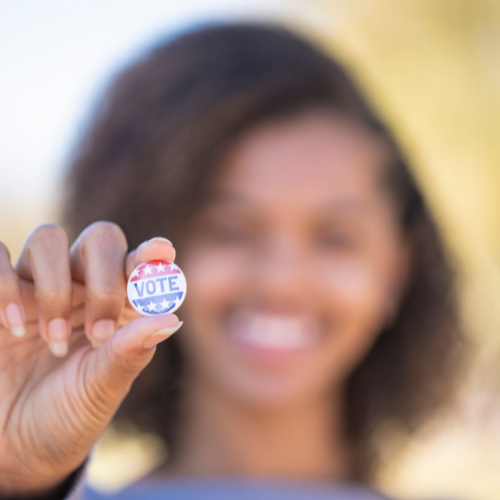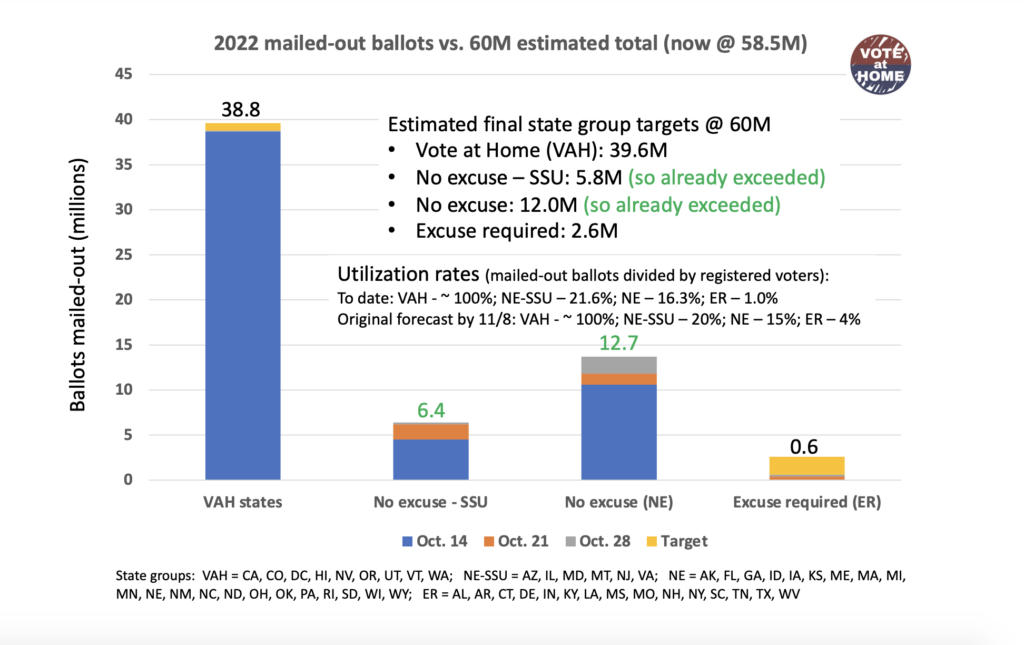October 28, 2022: Four years ago, if you had noted that mailed-out ballot voting in volume was largely a western state phenomenon, you would have been largely correct. The four “vote at home (VAH)” states at that time were CO, OR, UT and WA. And the mailed-out ballot use states with “permanent absentee” or “single sign-up” policies, where over 50% of voters cast their votes from ballots they received in the mail, included AZ and MT. But with the benefit of detailed tracking at the state level for the 2022 mid-terms using National Vote at Home Institute’s MOBET tool, we can see the adoption of this voting model now impacting states across the country.
To be fair, of the 17.4 million forecasted increase in mailed-out ballots (60 million up from 42.6 million in 2018) about 13 million or about 75% are coming from the five new Vote at Home jurisdictions (CA, DC, HI, NV, VT), with eight million of those from California alone. But there are some other very large movers in the non-VAH states.
Michigan, which passed no excuse absentee in 2018, was already an upside outlier in mailed-out ballot use given its prior policy. They are going from 1.1 million to 1.8 million, or put another way, from 15.6% utilization by their registered voters to 21.6%.
More impressive are two other states that have changed policy since 2018.
Pennsylvania passed no excuse absentee in 2019. They are going from 216,000 to 1.3 million or 3.5% utilization to 14.7% of their registered voters.
But the biggest mover is Massachusetts. They passed no excuse absentee in early 2022. They are going from 105,000 in 2018 to 1.1 million this year, or from 3.3% utilization to 22.5%. MA included in their no excuse “VOTES” Act a provision whereby the SoS is required to send a mailed-out ballot application to every registered voter for every election. That undoubtedly accounts for a major portion the differential lift between PA and MA.
Hitting 60 million (or more) mailed-out ballots means that voting using that model has gone “mainstream” beyond the few initial states in the western third of the country. Depending on total turnout, and return rates for those mailed-out ballots, about one-third of all US votes or more will have been cast by a ballot the voter received in the mail, in a non-pandemic emergency rules year.
It will demonstrate that with the big upticks in MA, MI and PA, and smaller but still important ones in states like MD (up 400,000), NJ (up 400,000), VT (up 400,000) and IL (up 300,000), coupled with DC just voting to be the second jurisdiction in the east (after VT) to mail ballots to all registered voters, this policy now has strong legs nationwide.
Better mailed-out ballot access policies are welcomed and embraced by voters.
The numbers tell us that policy matters, and implementation does too.
That second order potential impact is how the policy is rolled out. The Massachusetts case is instructive. By mailing applications to all, they increased the ease of access to the new policy, and the voters responded. Illinois passed a “single sign-up (SSU)” law a few years ago where voters can opt in to always have their ballot delivered in the mail, essentially making themselves a “vote at home” voter. But just this year, Illinois started promoting signing up for that option, which should result in that state seeing an even larger increase in mailed-out ballot requests in 2024. If Michigan passes its “Proposal 2,” which includes a SSU provision, they will see higher numbers, too.
To summarize: Our forecast remains: Mailed-out ballot activity will increase at least 40% in 2022 versus 2018 levels – to an estimated 60 million mailed-out, with over 42 million returned. Today, the mailed-out number hit 58.5 million.
The MOBET tool presents mailed-out ballot totals – and eventual return rates – in four categories:
- 9 “Vote at Home” (VAH) jurisdictions, where every active registered voter receives a ballot in the mail automatically for every election
- 6 “No Excuse – Single Sign-Up” (NE/SSU) states, where any voter, through a single application, can sign up to automatically receive ballots for all future elections
- 21 “No Excuse” (NE) states, where all voters are eligible to receive a ballot, but must request them for each specific election or every year
- 15 “Excuse Required” (ER) states, where most voters are ineligible to apply for a mailed-out ballot, unless they meet a specific legally acceptable excuse



